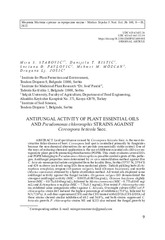Приказ основних података о документу
Antifungal activity of plant essential oils and Pseudomonas chlororaphis strains against Cercospora beticola Sacc.
| dc.creator | Starović, Mira | |
| dc.creator | Ristić, Danijela | |
| dc.creator | Pavlović, Snežana | |
| dc.creator | MÖZCAN, Mehmet | |
| dc.creator | Jošić, Dragana | |
| dc.date.accessioned | 2023-07-08T15:04:06Z | |
| dc.date.available | 2023-07-08T15:04:06Z | |
| dc.date.issued | 2021 | |
| dc.identifier.issn | 0352-4906 | |
| dc.identifier.issn | 2406-0828 | |
| dc.identifier.uri | https://plantarum.izbis.bg.ac.rs/handle/123456789/619 | |
| dc.description.abstract | Leaf spot disease caused by Cercospora beticola Sacc. is the most destructive foliar disease of beet. Cercospora leaf spot is controlled primarily by fungicides because the non-chemical alternatives do not provide commercially viable control. One of the ways of reducing chemical application is the use of different essential oils (EOs) or antagonistic plant growth-promoting rhizobacteria (PGPB). This study evaluates several EOs and PGPB belonging to Pseudomonas chlororaphis as possible control agents of this pathogen. Antifungal properties were determined by in vitro microdilution method against five C. beticola monosporial isolates originated from the locality Brus, Serbia (53°53’ N, 21°04’E and 429 m above sea level) using EOs from medicinal plants: Turkish pickling herb (Echinophora tenuifolia), oregano (Origanum vulgare), basil (Ocimum basilicum), and myrtle (Myrtus communis) obtained by a hydro-distillation method. All tested oils displayed some antifungal activity against the fungal isolates. Origanum vulgare EO demonstrated the strongest antifungal activity (MIC - 0.0055±0.0051mg/mL), Ocimum basilicum slightly lower (MIC - 0.075±0.045mg/mL), followed by Myrtus communis (MIC - 0.775±0.045 mg/ mL) and Echinophora tenuifolia (MIC - 7.75±4.5 mg/mL). Five tested P. chlororaphis strains exhibited some antagonistic effect against C. beticola. Overnight culture (ONC) of P. chlororaphis strain E65 induced the highest percentage of inhibition (75.8%), followed by N3 (72.0%). A cell-free supernatant (CFS) and the CFS treated with EDTA (CFS-EDTA) of these strains showed similar inhibition of 60.2 and 56.0%, and both strains suppressed C. beticola growth. P. chlororaphis strains M1 and K113 also reduced the fungal growth by 67-70% using ONC and between 48-57% using different CFS fractions. The strains L1 and B25 caused inhibition of 60% using ONC and 50% by CFS. The lowest inhibition (~40%) by CFS-EDTA and heat-treated cell-free supernatant (HT-CFS) was recorded for B25, which was used as a reference strain. The tested isolates of C. beticola were susceptible to all selected essential oils and P. chlororaphis strains E25, N3, M1, and K113 in vitro, making them a promising non-chemical control agent. It is recommended that these findings should be tested in field conditions. | sr |
| dc.language.iso | en | sr |
| dc.publisher | Matica Srpska | sr |
| dc.relation | info:eu-repo/grantAgreement/MESTD/Technological Development (TD or TR)/31018/RS// | sr |
| dc.relation | info:eu-repo/grantAgreement/MESTD/Integrated and Interdisciplinary Research (IIR or III)/46007/RS// | sr |
| dc.rights | openAccess | sr |
| dc.rights.uri | https://creativecommons.org/licenses/by-nc-nd/4.0/ | |
| dc.source | Zbornik Matice srpske za prirodne nauke | sr |
| dc.subject | antagonism | sr |
| dc.subject | CLS | sr |
| dc.subject | essential oils | sr |
| dc.subject | MIC | sr |
| dc.subject | Pseudomonas sp. | sr |
| dc.title | Antifungal activity of plant essential oils and Pseudomonas chlororaphis strains against Cercospora beticola Sacc. | sr |
| dc.type | article | sr |
| dc.rights.license | BY-NC-ND | sr |
| dc.citation.epage | 19 | |
| dc.citation.rank | M24 | |
| dc.citation.spage | 9 | |
| dc.citation.volume | 140 | |
| dc.type.version | publishedVersion | sr |
| dc.identifier.doi | 10.2298/ZMSPN2140009S | |
| dc.identifier.fulltext | http://plantarum.izbis.bg.ac.rs/bitstream/id/2680/bitstream_2680.pdf |


